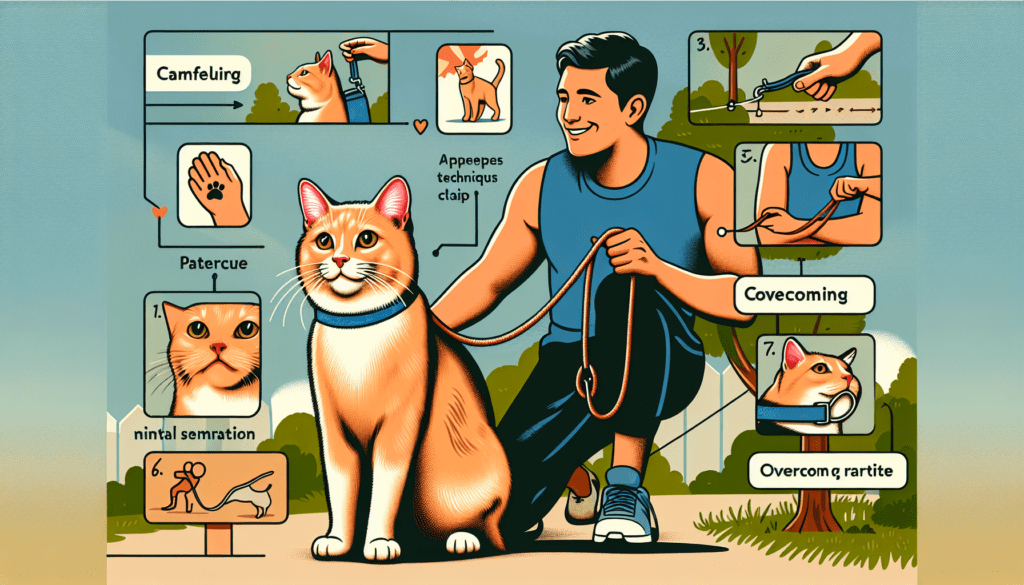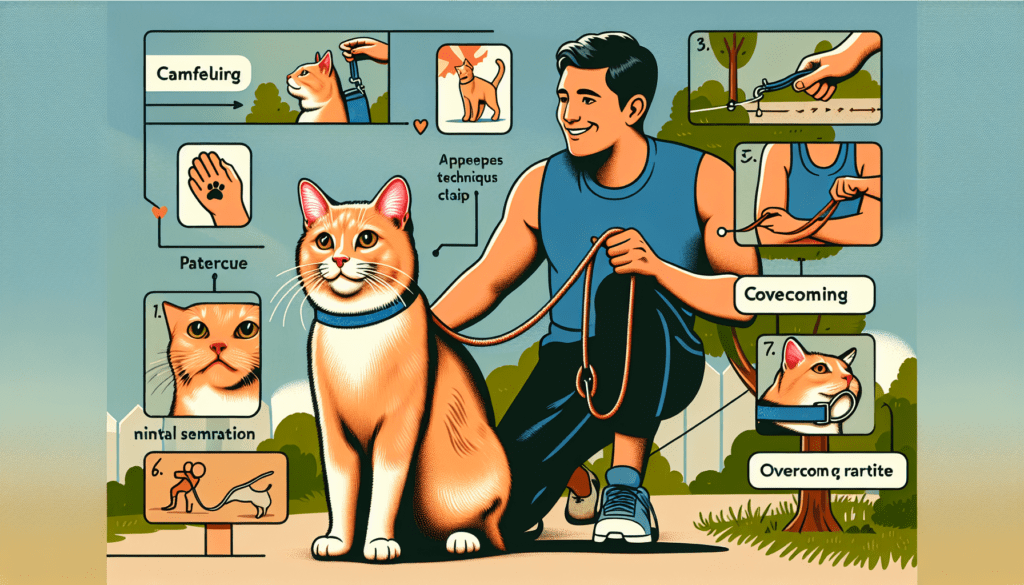Imagine being able to take leisurely walks outside with your furry feline friend by your side, exploring the world together. It may seem like a far-fetched dream, but with the right approach and a little bit of patience, you can actually train your cat to walk on a leash. Yes, you read that correctly – your independent and often aloof pet cat can become a seasoned leash walker. In this article, we will share some tips and tricks to help you successfully train your cat to walk on a leash, ensuring that both you and your feline companion can enjoy the great outdoors together.


Choose the Right Equipment
Find a suitable leash and harness
When it comes to training your cat to walk on a leash, having the right equipment is essential. Choose a leash and harness that are specifically designed for cats. Look for a harness that fits comfortably around your cat’s neck and torso, without being too loose or too tight. Ensure that the leash is made of a durable material that won’t easily break or fray.
Ensure the leash is long enough for your cat’s comfort
Cats enjoy exploring their surroundings and having some freedom to roam. Therefore, it’s important to choose a leash that is long enough to accommodate your cat’s natural curiosity. A leash that is too short may restrict your cat’s movements and cause them to feel uncomfortable or anxious. Aim for a leash that is at least 6 feet in length, allowing your cat to explore their environment while still remaining under your control.
Adjust the harness properly
Once you have chosen a suitable harness, it’s crucial to adjust it properly to ensure your cat’s comfort and safety. Make sure the harness is snug but not too tight, allowing your cat to move freely without any restrictions. Check that the straps are correctly positioned and that there is no excessive pressure on your cat’s neck or shoulders. Taking the time to adjust the harness correctly will minimize any discomfort or irritation for your feline friend.
Gradually Introduce the Equipment
Allow your cat to sniff and explore the leash and harness
Before putting the leash and harness on your cat, let them become familiar with these new items. Cats are known for their keen sense of smell, so allow them to sniff and investigate the leash and harness at their own pace. This will help to reduce any apprehension or fear they may have towards these items.
Reward your cat for positive interactions with the equipment
As your cat shows interest in the leash and harness, reward their positive interactions. This could include offering treats, praise, or a favorite toy. By associating positive experiences with the equipment, your cat will begin to view it in a more positive light.
Create Positive Associations
Associate the leash and harness with pleasant experiences
In order to make the leash and harness a positive part of your cat’s routine, associate them with pleasant experiences. Use treats, toys, or other rewards during training sessions to create an enjoyable atmosphere. This will help your cat to see the leash and harness as something that leads to fun and exciting adventures.
Offer treats and praise during training sessions
During the training process, make sure to reward your cat for their efforts and progress. Use treats and offer verbal praise when your cat successfully walks with the leash and harness or shows positive behavior during the training process. This positive reinforcement will encourage your cat to continue with their training and reinforce the idea that walking on a leash is a rewarding experience.
Use verbal cues to signal the start of a walk
Verbal cues can be a helpful tool in training your cat to walk on a leash. Choose a specific phrase or word to signal the start of a walk, such as “let’s go” or “time to explore.” Consistently using the chosen verbal cue will help your cat understand when it’s time to go outside and walk on a leash. Be sure to follow through with the walk after giving the verbal cue to reinforce the association.
Start Indoors
Choose a quiet and familiar area to start training
When beginning your cat’s leash training journey, it’s important to select a quiet and familiar area for the initial training sessions. This could be a room in your home where your cat feels comfortable and relaxed, such as a living room or bedroom. By starting in a familiar environment, your cat will be more at ease and open to learning.
Attach the leash and harness indoors
Once you’re in the chosen training area, attach the leash and harness to your cat while indoors. This will allow your cat to become accustomed to the feeling of wearing the harness and dragging the leash. Start with short periods of time and gradually increase the duration as your cat becomes more comfortable.
Allow your cat to drag the leash while supervised
As your cat adjusts to the harness and leash, you can start allowing them to explore their surroundings while dragging the leash under your supervision. This will help your cat to become accustomed to the sensation of being on a leash and give them the freedom to explore within the confines of your chosen training area.


Practice Handling and Leash Guidance
Gently handle your cat’s paws, tail, and body to desensitize them
To prepare your cat for outdoor walks, it’s important to desensitize them to being touched and handled. Start by gently handling your cat’s paws, tail, and body, just as you would during a regular grooming session. This will help your cat become more comfortable with being touched and minimize any possible resistance or anxiety when you handle their leash or adjust their harness.
Offer treats and praise for calm behavior during handling
During the handling process, be sure to offer treats and verbal praise for calm and cooperative behavior from your cat. This positive reinforcement will help to build a positive association between handling and rewards. Over time, your cat will begin to associate being handled with pleasurable experiences, making the leash training process smoother and more enjoyable for both of you.
Guide your cat’s movements with the leash
Once your cat is comfortable with wearing the harness and being handled, you can begin guiding their movements with the leash. Use gentle cues to direct your cat’s direction and pace, allowing them to explore their environment while still maintaining control. This will help your cat understand the concept of walking on a leash and following your lead.
Reward-Based Training
Use positive reinforcement techniques
When training your cat to walk on a leash, it’s essential to use positive reinforcement techniques. Reward your cat with treats, praise, or playtime whenever they exhibit the desired behaviors, such as walking calmly on the leash or responding to your cues. Positive reinforcement will motivate and encourage your cat to continue with their training and make the experience more enjoyable for both of you.
Offer treats and praise for desired behaviors
Consistently reward your cat for displaying the desired behaviors during the training process. Whether it’s walking alongside you, stopping when you stop, or responding to cues, make sure to provide treats and praise as a form of positive reinforcement. This will reinforce the behaviors you want to see and encourage your cat to repeat them in the future.
Avoid punishment or force
When training your cat to walk on a leash, it’s important to avoid using punishment or force. Cats respond much better to positive reinforcement and gentle guidance rather than harsh discipline. Punishment or force can lead to fear, stress, and a negative association with the training process. Focus on creating a positive and enjoyable experience for your cat to promote successful training.
Take It Slow and Be Patient
Progress at your cat’s pace
Every cat is unique and may require different amounts of time to learn and adjust to walking on a leash. It’s important to be patient and progress at your cat’s individual pace. Resist the temptation to rush the training process as this may lead to your cat feeling overwhelmed or anxious. Pay attention to your cat’s body language and adjust the training accordingly to ensure their comfort and wellbeing.
Don’t rush the training process
Training your cat to walk on a leash is a gradual process that requires time and patience. Remember that your cat is experiencing new sensations and environments, so it’s crucial to allow them to adapt at their own pace. Rushing the training process can be counterproductive and may result in your cat feeling stressed or resistant to further training. Take it one step at a time and be prepared for setbacks along the way.
Celebrate small achievements
Each milestone achieved during the training process is a cause for celebration. Whether it’s your cat walking a few steps on the leash or responding to a verbal cue, celebrate these small achievements with treats, praise, and affection. Recognizing and rewarding your cat’s progress will boost their confidence and motivation, making the training experience more positive and enjoyable for both of you.
Transition to Outdoor Walks
Choose a quiet and safe outdoor area for initial walks
Once your cat has become comfortable with the leash and harness indoors, it’s time to transition to outdoor walks. Choose a quiet and safe outdoor area for your cat’s initial walks, such as a fenced backyard or a secluded park. This will minimize distractions and potential dangers, allowing your cat to focus on their new outdoor experience.
Monitor your cat’s reactions and comfort level
As you take your cat for their first outdoor walks, it’s important to closely monitor their reactions and comfort level. Keep an eye out for signs of fear, anxiety, or stress, such as flattened ears, dilated pupils, or attempts to escape the harness. If your cat shows signs of distress, calmly and slowly lead them back indoors and continue with indoor training sessions until they are more comfortable.
Increase the duration and distance of walks gradually
Once your cat has mastered short walks in a safe outdoor area, you can gradually increase the duration and distance of your walks. Pay attention to your cat’s energy level and body language during the walks, and allow them to set the pace. Some cats may be more adventurous and eager to explore, while others may prefer shorter and calmer walks. Remember to be flexible and adjust your walks to accommodate your cat’s individual preferences and needs.
Manage Safety and Security
Always supervise your cat during outdoor walks
When taking your cat for outdoor walks, it’s crucial to always supervise them. Never leave your cat unattended while they are on a leash, as this can put them at risk of encountering dangerous situations or predators. Stay close to your cat and be prepared to react quickly in case of any emergencies. Supervision is key to ensuring your cat’s safety and preventing any potential accidents or injuries.
Avoid busy streets and keep a watchful eye for potential dangers
When selecting outdoor walking routes, it’s important to avoid busy streets or areas with heavy traffic. These environments can be overwhelming for cats and increase the risk of accidents. Opt for quieter and less crowded areas where your cat can explore and enjoy their walk with minimal exposure to potential dangers. Always keep a watchful eye for any potential hazards, such as stray animals, toxic plants, or unsafe objects.
Consider using a reflective collar or ID tag
To further enhance your cat’s safety during outdoor walks, consider using a reflective collar or attaching an ID tag. Reflective collars help to improve visibility, especially during low-light conditions, making it easier for others to spot your cat. An ID tag with your contact information is crucial in case your cat accidentally gets loose or lost during a walk. Taking these extra precautions will give you peace of mind and provide an added layer of security for your cat.
Consistency and Reinforcement
Continue ongoing training sessions for reinforcement
Even after your cat has become comfortable with walking on a leash, it’s important to continue with ongoing training sessions for reinforcement. This will help to maintain their skills and ensure that they continue to respond to cues and walk calmly on the leash. Regular training sessions will also provide mental stimulation for your cat and help strengthen your bond.
Maintain a consistent routine for walking your cat
Consistency is key when it comes to training your cat to walk on a leash. Establish a regular walking routine that works for both you and your cat. This could be a specific time of the day or a certain number of walks per week. Cats thrive on routine, and having a consistent schedule will help them feel more secure and confident during their walks.
Promote a positive and enjoyable experience for your cat
Above all, remember to make the walking experience positive and enjoyable for your cat. Pay attention to their needs, preferences, and comfort level throughout the entire training process. By promoting a positive and enjoyable experience, you’ll not only foster a love for walking on a leash but also strengthen the bond between you and your feline companion.

